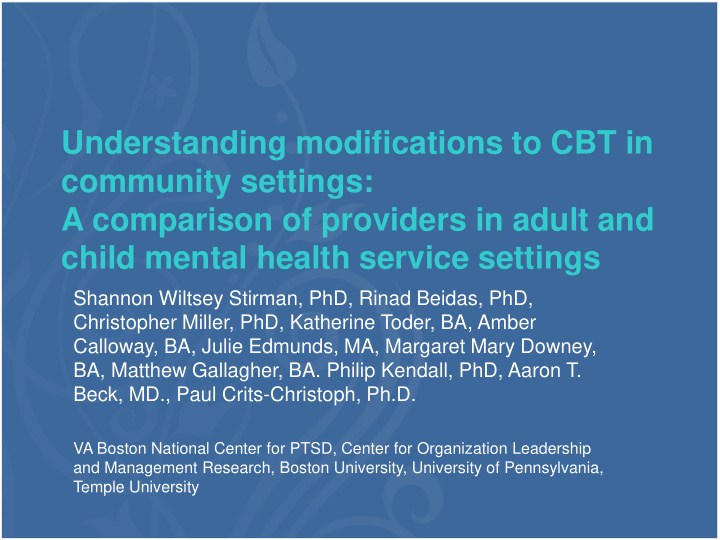



Understanding modifications to CBT in community settings: A comparison of providers in adult and child mental health service settings Shannon Wiltsey Stirman, PhD, Rinad Beidas, PhD, Christopher Miller, PhD, Katherine Toder, BA, Amber Calloway, BA, Julie Edmunds, MA, Margaret Mary Downey, BA, Matthew Gallagher, BA. Philip Kendall, PhD, Aaron T. Beck, MD., Paul Crits-Christoph, Ph.D. VA Boston National Center for PTSD, Center for Organization Leadership and Management Research, Boston University, University of Pennsylvania, Temple University
Acknowledgements • Philadelphia Department of Behavioral Health and Intellectual disAbilities – Arthur C. Evans, PhD – Bryce McLaulin, MD – Matthew Herford, MD – Regina Xhezo, MS • Andrea DeVito and Sam Meisel, B.A.
Fidelity and Modification • In implementing and sustaining programs and interventions, balancing between fidelity and modification is critical – Fidelity-the skilled/appropriate delivery of key components of the intervention—some evidence that fidelity is necessary for good outcomes – Modification-changes (proactive or reactive) made to the intervention/program when implemented in routine care • Adaptation-proactive, planned changes to the intervention or program to address contextual factors
Not all modifications are equal? • Little research on impact of modifications • Relatively few distinctions between types of modifications – Literature on cultural adaptation – Some studies on lengthening/shortening protocols – Some studies on different formats/settings personnel
Implications of modification • Largely unknown—findings have been mixed – Adaptations to PTSD treatments do not appear to negatively impact results (Levitt, 2007; Galovski, 2012) • BUT-highly specified parameters – Similar or improved outcomes when some programs were adapted to fit the needs of the community (Kalichman, 1993; Kennedy, 2000) – Others found worse recipient-level outcomes (Stanton, 2005) despite increased retention (Kumpfer, 2002)
Framework to classify modifications • Identified 32 articles that described 258 modifications • Used a coding process rooted in Grounded Theory to characterize modifications • Developed a framework describing contextual and content-related modifications and adaptations
Modifications to Cognitive Therapy in a mental health system • Adult Sample – Interviews with 27 clinicians in a variety of settings in the City of Philadelphia’s mental health system – Descriptions of modifications were segmented and coded using the framework – 175 modifications identified – All endorsed at least 1 modification
Modifications to Cognitive Therapy in a mental health system • Child Sample – Interviews with 50 clinicians in a variety of settings in the City of Philadelphia’s mental health system – Descriptions of modifications were segmented and coded using the framework – 165 modifications identified – 38/50 clinicians endorsed at least 1 modification
Examples • I wouldn't just translate it from English to Chinese, ‘What does that mean for you?’ directly, because he might feel insulted. He might have felt that I didn’t respect him. So I needed to explain it to him in a much more roundabout way. (tailoring) • I find it to be more effective to just have a general conversation and integrate CT during the conversation. I think it’s a more naturalistic approach to things and the participants I think feel more relaxed that way. (loosen structure) • If I feel like there’s a need for [a CT intervention] or someone is really going to benefit from it I insert it to what I’m already doing sort of or borrow bits and pieces of it here and there but never the full thing (Integrating)
Contextual Modifications Adult Child Context Modifications Frequency % of total Frequency % of total modifications modifications Format 1 <1 9 <1 <1 Setting 3 2 12 0 Personnel 0 0 0 0 Population 0 0 0 Training and Evaluation Processes 1 <1 0 0 Content Modifications Level 22 Individual Recipient 99 57 37 27 Cohort 0 0 44 Population 15 9 85 51 Provider/Facilitator 57 33 0 0 Unit 2 1 0 0 Organization 1 <1 0 0 Network/Community 0 0 0 0
Content-level modification-Adult Type of Modification Frequency % of total modifications Number of Clinicians Endorsing Tailoring 31 18 16 Loosening Structure 30 17 12 Integrating the intervention into another 28 18 12 approach/framework Drift or depart from the intervention 25 14 15 Integrating another approach into the 11 6 6 intervention Lengthen/extend session or protocol 9 5 5 Removing elements 5 3 4 Adding components 4 2 2 Shortening/condensing session or protocol 3 2 2 Substituting Elements 0 0 0 Re-ordering components 0 0 0 Repeating elements 0 0 0
Content-level modification-Child Type of Modification Frequency % of total modifications Number of Clinicians Endorsing Tailoring 24 14 18 6 4 6 Loosening Structure 52 31 26 Integrating the intervention into another approach/framework 39 23 24 Drift or depart from the intervention Integrating another approach into the 14 8 11 intervention 1 .6 1 Lengthen/extend session or protocol 24 14 19 Removing elements 0 0 0 Adding components 8 5 7 Shortening/condensing session or protocol -- -- -- Substituting Elements 1 .6 1 Re-ordering components Repeating elements 0 0 0
Summary • Modifications made by clinicians serving adults and children differed • Child clinicians made more modifications at the population and cohort level, adult clinicians at individual client or clinician level • Clinicians serving adults loosened structure more • Clinicians serving children integrated, removed components, and drifted more
Implications for implementation • Modifying and adapting may increase stakeholder buy-in and improve perceptions of fit • Endorsement of drift, integration of other approaches, loosening structure suggests that CT is not being sustained as presented in training • Impact on implementation and client-level outcomes is not yet known
Implications for implementation research • This framework provides researchers with a way of identifying different types of modifications • Codes can be used in analyses to understand the impact of specific types of modifications • Further research is needed to understand its reliability and utility for different interventions and data sources
Recommend
More recommend